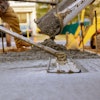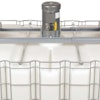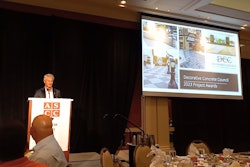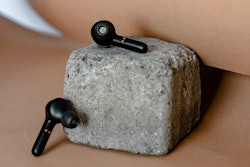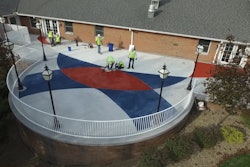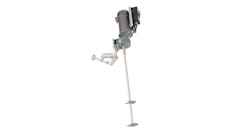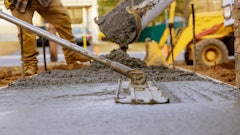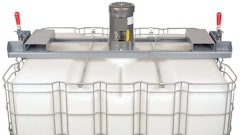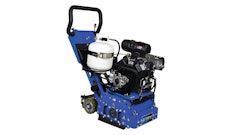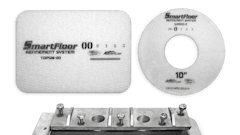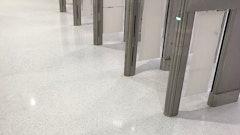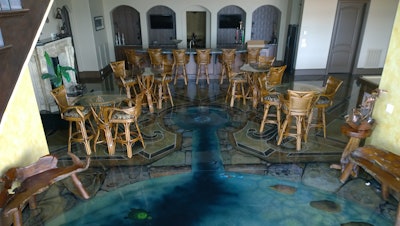
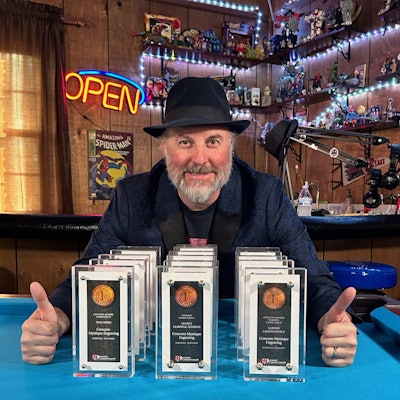 Rick Lobdell, MFA, owner of Concrete Mystique
Rick Lobdell, MFA, owner of Concrete Mystique
Anyone active in the decorative concrete industry may very well recognize Rick Lobdell. The multiple award-winning contractor has been an active member of the American Society of Concrete Contractors (ASCC) since 2013 and joined the board of the Decorative Concrete Council (DCC) a year later. He retired two years ago but continues to share his experience at Surface Koatings Inc. (Surfkoat), one of the main stain manufacturers he used while in business, and a current judge of the DCC Awards.
He and his team at Concrete Mystique specialized in custom-designed murals, seals, solid colors, and overlays in the $750,000 to $1.5 million house market—everything except for vertical work.
Anything worthwhile comes through hard work. Though beautiful, the work was grueling often requiring him to lay on the slab for 10 hours a day which left his arms, palms, and elbows stained from color. Though he says that painting a mural on a slab for that long is one the most painful things he’s ever done, the hardest was training somebody else to do what he does and then walk away.
“Considering it’s an art form, you have to have a background in art,” says Lobdell. “There’s not too many artists out there that want to get their hands dirty like I do.” He had trouble figuring out how to move forward, so he retrained his team on the foundations—design, patterns, overlay, stain, seal, etc.
However, it was never just art. “Everybody always thought that all I did was art,” he says. “I would not have made money if I only did art.”
His Start
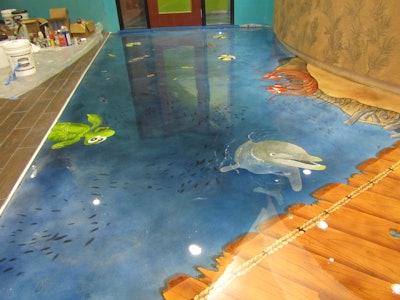 Rick has created a reputation for using color to create a visual depth within his floor designs.Concrete Mystique
Rick has created a reputation for using color to create a visual depth within his floor designs.Concrete Mystique
Later, he moved to Nashville after marrying and fought hard to find work where he could, went back to tile, and even taught dancing—but couldn’t find consistent work. “Finally, one day, I went to this interview for Concrete Mystique and they were showing us what we could do,” explains Lobdell. “There was 15-20 people in the interview and they were only hiring one. I’m sitting there, listening to him and I went ‘Hold on…you’re telling me this isn’t tile? I don’t understand how it was concrete.’”
They explained that they engraved the design into the concrete, using grout lines to make it look like tile. After learning he wouldn’t need to lug boxes of fragile tile and heavy thin-set cement board up flights of stairs but work on the concrete already there he was hooked. He was hired after the two-week trial.
Sometimes, perseverance truly pays.
Six months later the team in charge left. Within 3 years he found himself the manager of the crews and coming up with new ideas. The company’s specialty was 1-ft. tile which mimicked the look of a 12x12 in. tile on concrete and decision-makers were reluctant to change. Finally, even though he’d never done anything like it before, he convinced a job to include a compass rose design. His boss agreed after showing a photo and approved adding $500 for the work. He came back with an extra $1,000 in a week. In 2007, Lobdell purchased the Concrete Mystique company.
“When I first started, you had a two-week training class and then you were given a trailer, and you were on your own doing projects. I was engraving. I was doing a pool deck by myself," he says. It's a different industry today. "There is no way I could do that now. Not even close,” says Lobdell. Under his watch, it required at least 6 months of training before someone was “on their own” at a jobsite.
One of the (many) lessons learned for Lobdell early on was that any imperfections in the concrete were going to be seen. Any spills, trowel marks, different sheens, and broom marks, all would be easily visible if the concrete was only stained and sealed. “But,” he says, “if you added a tile pattern, all of a sudden all those imperfections become cool tile imperfections. These imperfections become positives to everything in the tile.”
For years he stuck to only acid staining and sealing until a friend convinced him to try epoxy and urethane which eventually took him from Nashville to nationally recognized.
The challenge with custom designs, metallic epoxies, or flake garage floors was business. He found that his team only captured those types of jobs once every two months or so. On the other side of that, they did acid stain, solid colored sealer, or a basic tile pattern often.
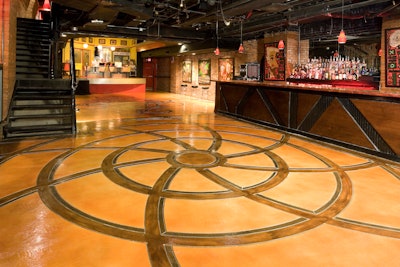 The floor of a dinner theater in Nashville - one of the many designs that caught the attention of the decorative concrete industry.Concrete Mystique
The floor of a dinner theater in Nashville - one of the many designs that caught the attention of the decorative concrete industry.Concrete Mystique
“You have to be careful. You can follow your lines and relatively cut that with no problem…but when you switch to doing it on a curve, that changes everything. Trying to do those start and stop points at those intersections while maintaining a curve was grueling,” he says. His process had someone holding center while he transferred the geometric Cartesian coordinates onto the slab with soapstone. The curves were freehanded with an angle grinder and a Cobra engraver from Engrave-A-Crete helped with the straight lines.
His consulting with customers advice for contractors: sell the design. “My biggest goal is to figure out what you [the customer] want. If I can find something about you, I’ve sold the project no problem,” he says. Case in point, one custom design for a backyard patio featured a specific design inspired by the customer. Lobdell noticed a design in her curtains and pillows during the consultation conversation and offered to use that as a reference for the floor.
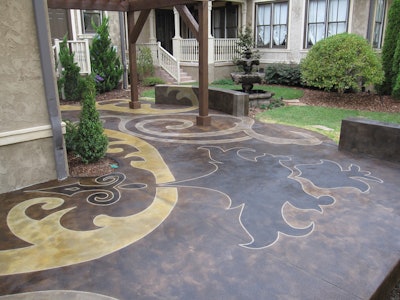 A perfect example of capturing inspiration from a client to use as the design in this backyard patio.Concrete Mystique
A perfect example of capturing inspiration from a client to use as the design in this backyard patio.Concrete Mystique
Interestingly enough, he sketched most designs on paper throughout his career. Shocking many, he says he doesn’t use CAD or Photoshop. Other designs were done with a scaled reference picture and then drawn on the slab.
Lobdell explains the project: “I had an in-house concrete guy that worked with me. We talked about different surfaces [and] different techniques because I didn’t want just a broom finish. What he figured out was what he called ‘an antique rub.’” He figured out a way to provide a texture with slip resistance without the straight lines of a broom finish. He and the Concrete Mystique team ended up using this texture on every pour for a decade.
No matter what type of concrete, no contractor works alone. "It is so important to remember that there is a team involved with all of it," says Lobdell. Fitting they worked out of Nashville, he ran Concrete Mystique as if a band. "Once that sunk in, I started to realize that I need to remember the people that are helping me, are helping me. It might be my idea, but I can't do everything by myself. I need a team around me to help me out.
His biggest advice for contractors is to become a member of the ASCC. “ASCC is one of the most important things for any contractor to be involved with,” says Lobdell. “You have access to the best of the best when you need help and your manufacturer’s not available—you have a friend to call. You have a hotline to call.”
Editor’s Note: Lobdell hosts the Concrete Mystique Podcast, is a commentator for the YouTube show “Epoxy Floor Wars” presented by Epoxy Depot, and can be found on Facebook at https://www.facebook.com/rick.lobdell.


